Abstract
The two-state lasing phenomenon, which manifests itself in simultaneous laser emission through several optical transitions of quantum dots, is studied in microdisk diode lasers with different cavity diameters. The active region represents a multiply stacked array of self-organized InAs/InGaAs/GaAs quantum dots emitting in the wavelength range of 1.1–1.3 µm. Two-state lasing, which involves the ground-state and the first excited-state optical transitions, is observed in microdisks with cavity diameters of 20 to 28 µm, whereas two-state lasing via the first and the second excited-state optical transitions is observed in 9 µm microdisks. The threshold currents for one-state and two-state lasing are investigated as functions of the microdisk diameter. Optical loss in the microdisk lasers is evaluated by comparing the two-state lasing behavior of the microdisks with that of edge-emitting stripe lasers made of the same epitaxial wafer.
1. Introduction
For the last few decades, microlasers with disk and ring cavities that support propagation of high-Q whispering gallery modes (WGM) have been intensively studied and discussed. Microdisk (MD) and microring lasers based on III-V semiconductors have a high potential for their implementation in the photonic integrated circuits, because they have a small footprint, demonstrate low threshold currents and narrow linewidths, and emit light in the lateral direction [1,2]. MD lasers with a quantum dot (QD)-based active region demonstrate much better performance compared to their InGaAs QW-based counterparts. Continuous-wave operation of QD microdisks was already observed at elevated temperatures of 100–110 °C [3,4]. It is worth mentioning that small sizes of microlasers, in combination with the low sensitivity of QDs to surface recombination and epitaxial defects, open up opportunities for monolithic [5,6] and hybrid [7,8] integration of such emitters with silicon or other non-native substrates. At the same time, good thermal conductivity of silicon lowers thermal resistance of hybrid integrated devices and improves their output characteristics [9]. QD-based MD and microring lasers show direct modulation frequencies of about 6–7 GHz for lasers grown both on GaAs [10] and Si [11]; error-free optical data transmission at 10 Gb/s has been demonstrated. A further improvement in the performance of microlasers can be associated with an increase of the throughput of such systems by, for example, transmitting data at multiple carrier frequencies, similar to the wavelength division multiplexing used in fiber optic communication.
QD lasers exhibit a specific feature referred to as two-state lasing, which consists of simultaneous emission through the optical transitions involving ground-state and excited-state energy levels of quantum dots [12,13]. A reason for such a behavior is related to the non-instant capture of charge carriers from the excited-state (ES) levels to the ground-state (GS) one that results in a gradual increase in population of the excited states. At a sufficiently high current, which can be considered as a threshold of two-state lasing, optical gain on the first excited-state (ES1) optical transition becomes sufficient to balance optical loss in the laser cavity, which leads to the appearance of stimulated emission for the ES1 optical transition. Two-state lasing is somewhat similar to widely tunable lasing, because both exploit the excited-state optical transition of QDs. However, the former effect manifests itself in a conventional laser cavity, whereas the latter requires a certain spectrally selective element.
Two-state lasing can be useful for realization of broad-band laser emission. For example, very broad lasing spectra of about 75 nm in the 1.2–1.28 μm wavelength range have been achieved by intentional inhomogeneous broadening of the GS optical transition peak and contribution of lasing via the excited-state transitions [14]. A possibility of spectral filtering of individual Fabry-Perot modes and their independent external modulation at 10 Gb/s with a bit error rate less than 10−13 has been demonstrated [15]. In [16], an all-optical switching mechanism between the GS and the ES emission of a QD laser has been demonstrated. Very fast times on the order of several hundreds of picoseconds were obtained for switching between the states. A novel encoding scheme that combines advantages of multilevel signaling and wavelength division multiplexing by exploiting the switching from the GS to ES lasing in QD lasers with an increase in injection current was proposed in [17]. Groups of two bits have been proposed to assign to lasing spectra that comprise either one or both GS and/or ES1 lasing or absence of lines depending on injection current, which can take one of four levels. The abovementioned results show the aptitude of two-state lasing in QD lasers for high-speed optical data transmission.
Two-state lasing can only be observed in a certain range of optical loss [18]. On the one hand, if the loss is too low, the onset of two-state lasing requires unpractically high current density. On the other hand, if the loss is too high, lasing starts immediately through the ES1 optical transition, while the GS spectral component is not observed. Since optical loss can be easily changed in stripe lasers by varying the cavity length, to date, two-state lasing has been investigated in detail, both experimentally and theoretically, for the stripe QD lasers. Dynamic characteristics associated with the switching of lasing between different states of quantum dots in such lasers were investigated in [19] using a reverse biased absorber section. Temperature evolution of two-state lasing conditions were studied in [13,20]. An analytical description of two-state lasing and its characteristics, in particular, quenching of the GS emission at high injection levels, were investigated in [21,22,23]. An influence of modulation p-doping of QDs, which results in a change of lasing threshold currents, was studied in [18]. In a QD microdisk with a diameter of 1 μm, lasing under optical pumping was observed through the ES1 optical transition [24].
However, the two-state lasing phenomenon has not yet been studied in QD-based microlasers. The present work is aimed at eliminating this gap and is focused on an experimental study of the emission characteristics of microlasers with disk cavities of various diameters comprising InAs/InGaAs/GaAs QDs. In the case of MDs, optical loss is varied by changing the cavity diameter [3] similar to changing the resonator length in stripe lasers, which, as we will show, leads to an appearance of a dependence of the threshold current densities for GS- and ES-lasing on the microdisk diameter.
2. Materials and Methods
A laser heterostructure for experimental studies was grown by molecular beam epitaxy on an n+-GaAs substrate with a 500 nm thick n+-GaAs buffer layer. The laser light-emitting region represents a QD array formed by consistent deposition of 2.5 monolayers of InAs followed by deposition of 5 nm In0.15Ga0.85As. The structure contains 10 layers of QDs separated from each other by GaAs spacer layers of 35 nm thickness, with the central part doped with acceptors with concentration of 5 × 1017 cm−3. The waveguiding layer is sandwiched between n+ and p+ Al0.25Ga0.75As claddings with a thickness of 2.5 and 2.2 µm, respectively. The structure was terminated with a heavily doped p+-GaAs contact layer of 200 nm thick.
Microdisk cavities were formed from the laser heterostructure by photolithography and plasma-chemical etching. The microlasers are about 28, 24, 20 or 9 µm in diameter and about 6 µm in height. According to our estimates, the effective volume of the WGM varied from 35 to 8 μm3 for resonators with a diameter within the specified range. Round-shaped metal contacts to the p+-GaAs layer were formed at the tops of the microcavities using AgMn/Ni/Au metallization. A solid AuGe/Ni/Au metal n-contact was deposited to the back side of the preliminarily thinned substrate. A scanning electron microscopy image of representative microdisks is depicted in Figure 1a. Chips with several microdisk lasers were soldered with indium to a copper heatsink, which was also used for electrical connection to the n-contact of the microlasers. A BeCu microprobe was used for individual connection to p-contact of separate microdisks.
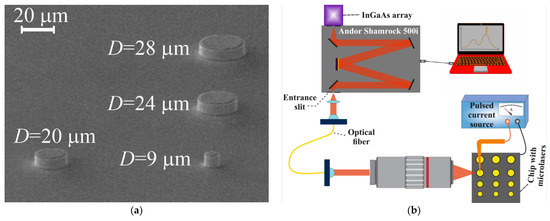
Figure 1.
Scanning electron microscopy image of the microdisks under study; length of the scale bar is 20 µm (a); sketch of the experimental setup (b).
The bias voltage to the microlasers was applied in a pulsed regime with a pulse width of 300 ns and repetition rate of 4 kHz in order to reduce possible influence of self-heating of the lasers. The pulsed current amplitude was measured using an inductive probe. The collection of electroluminescence from microdisks was carried out with a microobjective (Mitutoyo M Plan APO NIR 50x). Further, the electroluminescence emission was directed via a multimode optical fiber to an Andor Shamrock 500i grating monochromator with a diffraction grating containing 1200 lines per millimeter. The emission was detected by an InGaAs CCD array with thermoelectric cooling. When the integrated intensity of laser emission is discussed, it was obtained as the area under the respective spectral curves of lasing modes within a certain optical transition band, e.g. the GS one. The experimental setup is schematically drawn in Figure 1b. The results presented below are stable over time for at least a couple of hours and are reproducible for each specific microdisk.
For the sake of comparison of the spectral characteristics, broad area lasers were fabricated from the same epitaxial wafer. The stripe width was 100 µm. The cavity length varied from 0.25 to 2 mm. Cleaved facets were left uncoated. The lasing spectra and light-current curves of the stripe lasers were studied in pulsed regime. The slope efficiency and threshold current density were extracted.
3. Results and Discussion
3.1. Spectral Analysis of Microdisk Lasers
The electroluminescence spectra of spontaneous emission of the microdisk laser structures show several broad bands (full width at half maximum is about 50 nm). They were assigned to radiative recombination of charge carriers occupied several energy levels of the QDs and of the covering InGaAs quantum well. According to the emission spectra of the 20 µm microdisk presented in Figure 2a, spectral bands of emission related to the GS and three excited-state (ES1, ES2 and ES3) optical transitions of QDs are centered at room temperature near the wavelengths of 1265, 1170, 1100 and 1040 nm, respectively. The quantum well (QW) manifests itself as a weak spectral band located around 970 nm.
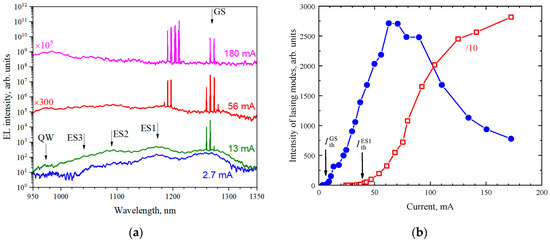
Figure 2.
Electroluminescence (EL) spectra of the 20 µm microdisk measured at different injection currents at room temperature (a) and dependence of the integrated intensity of lasing modes for GS (circles) and ES1 (squares) optical transitions (b). Several spectra in figure (a) are vertically shifted for better clarity with the appropriate coefficients shown in figure.
WGMs involved in lasing are observed in the spectra as narrow lines with a spectral width (limited by the spectral resolution) of less than 0.2 nm. As can be seen from Figure 2a, lasing first starts at the GS optical transitions of QDs; a representative spectrum is shown for a current of 13 mA. As the injection current grows (56 mA), lasing lines appear within the spectral band of the ES1 optical transition, which means that two-state lasing occurs. It should be noted that the additional line arises on the shorter-wavelength side of the spectrum. This distinguishes two-state lasing from injection current-induced switching of the lasing line to a longer wavelength cavity mode. The latter process is related to a temperature increase in the active region and is expected to be much slower compared to switching between the quantum states [16].
In brief, an appearance of two-state lasing in a QD laser [12,13] can be explained as follows. The charge carriers relax from the excited-state level to the ground-state one. A cascade relaxation of the charge carrier over a ladder of QD electronic states has been confirmed, for example, in experiments on time-resolved luminescence [25]. When lasing on the GS optical transition occurs, the population of the ES1 level does not clamp, and the ES1 gain continues growing with increasing the injection current. Finally, lasing on the ES1 optical transition starts.
A further increase in current (180 mA) leads to a gradual decrease in the intensity of lasing lines within the GS optical transition, while the lines within the ES1 optical transition continue to grow in intensity. These trends are clearly visible in Figure 2b, which shows the dependence on the injection current of the integrated intensities of lasing modes within the GS and the ES1 optical transitions for the same 20 µm microdisk laser. The lasing through the GS optical transition starts with a threshold current IthGS of about 6 mA, which was estimated from the kink in the GS light-current curve. Similarly, the threshold current of two-state lasing, i.e., the current IthES1 when the ES1 laser emission appears, was found to be about 40 mA. Although the integrated intensity of the GS laser emission continues increasing with current, at 60 mA the intensity of the ES1 emission already starts to dominate. After that, the GS intensity begins to decrease with further increasing current. Such a decrease of the GS lasing intensity at high injection currents in the two-state lasing regime was previously observed in edge-emitting QD lasers, and was explained in terms of the competition of GS- and ES1 electrons for “joint” holes and the difference in the hole and electron capture rates into QDs [26,27].
Microdisks with cavity diameters more than 20 µm show similar behavior but with different threshold currents IthGS and IthES1 (dependences of the threshold current density on the microdisk diameters will be discussed further). In all these cases, lasing also starts at the wavelengths corresponding to the GS optical transition, and at sufficiently high currents, two-state lasing occurs with simultaneous emission via the GS and ES optical transitions. It is worth mentioning that more than one WGM lasing line is typically observed within both the GS and ES1 emission bands. The spectral spacing between neighboring WGMs (free spectral range, FSR) is about 6.8, 5.8 and 5.0 nm for the 20 µm, 24 µm and 28 µm microdisks, respectively. These FSRs are significantly smaller than the minimum spectral distance between groups of the GS and ES1 lasing modes, which is 50 nm at least. This facilitates an individual detection of the spectral components involved into two-state lasing even at low spectral resolution of a detection system.
A slightly different situation is observed for the microdisk laser of the smallest diameter of 9 µm, where lasing first starts at the ES1 optical transition (Figure 3a, IthES1 ≈ 6 mA), and the GS laser emission is not observed at all. This indicates that the total optical loss, whatever its cause, in this small cavity exceeds the saturated gain achievable at the GS optical transition. Due to the higher degeneracy of the ES1 quantum level compared to the GS one, the optical gain at the ES1 optical transition turns out to be large enough to compensate the loss. It is seen that an increase in the injection current above the lasing threshold leads to an increase in the integrated intensity of the ES1 laser emission (Figure 3b). Once the current exceeds 90 mA (IthES2), the emergence of an additional blue-shifted lasing line is observed in the electroluminescence spectrum. This line (group of lines) is within the ES2 optical transition, so the two-state lasing effect in the 9 µm microdisk represents a combination of the ES1 and ES2 laser emission. Beyond the two-state lasing threshold, the intensity of the ES2 emission increases, while the intensity of the ES1 laser emission diminishes.
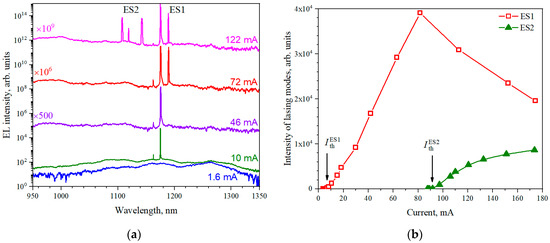
Figure 3.
Electroluminescence spectra of the 9 µm microdisk measured at different injection currents (a) and dependences of the integrated intensity of lasing modes for ES1 (squares) and ES2 (triangles) optical transitions on the injection current (b). Several spectra in figure (a) are vertically shifted for better clarity with the appropriate coefficients shown in figure.
It is unusual in QD lasers for two-state lasing to occur through ES1 and ES2 optical transitions rather than through the GS and ES1 ones, i.e., that the quantum numbers of lasing transitions are increased by one. As far as we know, the two-state lasing regime involving two excited-state optical transitions of quantum dots has not been observed so far. This suggests that the degree of degeneracy of the ES2 level is even higher than that of ES1. Although Stranski-Krastanow QDs have a more complex shape than a sphere, it can nevertheless be pointed out that the degree of degeneracy of the GS, ES1 and ES2 quantum levels in a sphere is 1, 3 and 5, respectively (without taking into account spin degeneracy).
3.2. Threshold Current Density of Microdisk Lasers
Next, the current densities of the laser thresholds were studied as a function of the microdisk diameter. Several microdisks of each diameter were studied. The obtained data are presented in Figure 4. The observed scatter of the current density can be associated with the influence of the dispersion of microcavity parameters caused by the roughness of the side walls and a possible deviation from the expected size and shape (see also the discussion of the data presented in Figure 6). Nevertheless, the trends on the plot are very distinct.
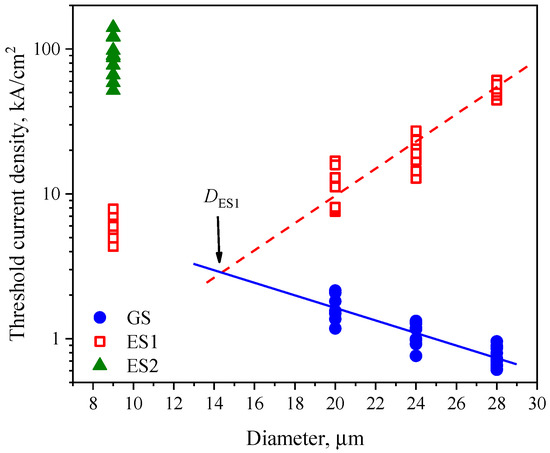
Figure 4.
Dependences of threshold current densities on microdisk diameter for lasing through different optical transitions: GS (circles), ES1 (squares), or ES2 (triangles). Lines are guides to the eye. Arrow indicates critical diameter for GS lasing.
An increase in the current density for the GS lasing threshold, JthGS, is observed with a decrease in the cavity diameter . This can be attributed to several physical mechanisms, such as non-radiative recombination at microdisk sidewalls or rise of optical loss in smaller disks. The former effect becomes significant if the device size is comparable to the carrier diffusion length Ld [28]. However, this is not the case for the QD microlasers under study, since Ld (which is about 0.1 µm [29]) is expected to be much smaller than the diameter. Another possible reason, which we believe to be the most important, is the growth in optical loss in smaller microdisks. In particular, light scattering by the sidewall roughness [30] and light absorption in the near-surface depleted region [31] depends on the diameter as .
Meanwhile, the current density for the onset of ES1 lasing, JthES1, decreases. This can be attributed to the fact that higher optical loss in smaller cavities causes higher charge carrier concentrations to occupy all excited-state quantum levels, including the ES1 one, which facilitates earlier lasing through the ES1 optical transition. This can be explained in terms of the Pauli blocking, which slows down the carrier relaxation rate from the ES1 level to the GS one when the latter is partly occupied [32]. Thus, the current density interval between JthGS and JthES1, where pure GS-lasing occurs, shrinks as the diameter gets smaller up to complete collapse at a certain critical diameter DES1. Once the microdisk becomes smaller than DES1, no GS lasing can be observed, and the first lasing threshold represents the onset of ES1-lasing, as discussed for the 9 µm microdisk. According to the extrapolation of the experimental data presented in Figure 4, the critical diameter is about 14 µm (at room temperature).
3.3. Broad Area Lasers
Estimation of loss from the spectral width of the lasing line faces difficulties caused by the uncertainty of the Henry factor, the effect of gain in the active region, and the influence of the spectral resolution of the optical measurement system. Since there is no simple formula for evaluating loss in a microdisk, it is useful to compare the microdisk characteristics with those of stripe lasers made of the same QD epitaxial wafer. Similar two-state lasing behavior has been observed for edge-emitting lasers when the stripe length shortens [33]. The critical point corresponds to the maximum optical loss, , at which GS lasing is still possible. In its turn, the value of is close to the saturated (maximum) optical gain, which can be achieved on the GS optical transition.
The measured lasing wavelength, threshold current density, and differential quantum efficiency of the broad-area lasers are presented in Figure 5a against the cavity length. It was found that the critical cavity length, LES1, at which lasing begins at the ES1 optical transition and GS lasing disappears, is approximately 0.4 mm. It falls within the interval from 425 to 375 µm, where the lasing wavelength λ drops from 1259 nm (GS) to 1172 nm (ES1), respectively. For even shorter laser cavities, one more jump in the lasing wavelength down to 1099 nm is observed. This wavelength corresponds to the ES2 optical transition, and the critical cavity length, LES2, falls in the range from 250 to 200 µm.
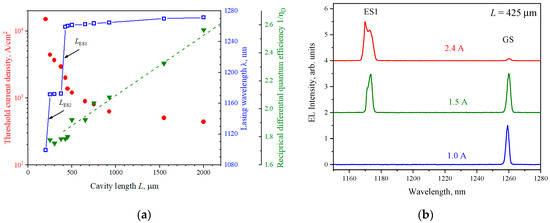
Figure 5.
Threshold current density (circles), lasing emission wavelength (squares) and reciprocal differential quantum efficiency (triangles) as function of stripe laser length (a). Lasing spectra (not to scale) taken at different currents for 425-µm-long sample (b).
The differential quantum efficiency data for the cavity lengths of GS lasing can be fitted well by the equation:
where is the internal efficiency of laser emission, 3.1 cm−1 is the internal optical loss, and R is the facet reflectivity, which is assumed to be 0.3. Using the obtained value of the internal loss, and taking into account that the output loss for stripe laser is , the maximum optical loss of GS lasing can be estimated as:
The calculation gives 33 ± 2 cm−1. Using Equation (2) with the critical length instead of , the maximum optical loss of ES1 lasing can be found, which is 57 ± 6 cm−1. It should be noted that the real value may be somewhat higher due to an increase in the internal loss in short laser cavities.
It is also worth mentioning that the two-state (GS-ES1) lasing effect is pronounced in the edge-emitting lasers with the cavity lengths close to the critical one, LES1 or LES2. As an example, Figure 5b demonstrates emission spectra measured at different injections for the 425 µm long laser. The ES1 emission appears already at a current of 1.15 A (2.71 kA/cm2), i.e., very close to the GS lasing threshold, which is 0.85 A (2 kA/cm2).
3.4. Comparison of BA and Microdisk Lasers
Returning to microdisk lasers, one can suggest the total loss in lasers with a diameter of 14 μm is equal to . It is natural to assume that the internal losses in the lasers of stripe geometry and in the microdisks are of the same value. If so, then the dependence of total optical loss on the diameter of the microdisk lasers under study can be described by the following equation:
where is a coefficient which describes the combined effect of sidewall roughness scattering and near-surface absorption. The value of the coefficient 421 cm−1 × µm was determined, taking into account that the loss reaches its maximum value when the diameter is equal to the critical one:
In [28], it was found that the optical loss in microdisk lasers with a dense array of InGaAs QDs is inversely proportional to the diameter with the coefficient A of 2000 cm−1 × µm. The modelling revealed that for those microdisk lasers, sidewall scattering is responsible for (16–390) cm−1 × µm, while the main contribution to the value of A (~1700 cm−1 × µm) is made by absorption by empty QDs in the near-surface region. The fact that the surface density of the InAs/InGaAs QDs in the microdisk lasers under study is approximately five times lower compared to that of [31] can explain a lower value of A in the former case. Using the parameter A, as well as the value of the maximum optical loss , estimated from the stripe lasers, it can be assumed that in microlasers of an even smaller diameter (7 μm or less), lasing will begin at the ES2 optical transition. It should be noted that the onset of two-state lasing is determined by the occupation of the QD states, which, in turn, depends not only on loss, but also on the saturated (maximum) modal gain of the active region. Thus, it is easier to achieve two-state lasing in a laser heterostructure with a lower saturated gain. Accordingly, the critical diameter will increase.
It is interesting to compare the threshold current densities obtained for the microdisk and the stripe lasers. These data are presented in Figure 6. It is seen that the lowest values of the threshold current density among microdisk lasers of the same diameter are in good agreement with those of the BA lasers. This indicates that nonradiative recombination at the side walls of the microdisks is insignificant. Otherwise, surface recombination would lead to higher threshold current densities in all microdisks. A number of microdisk laser data points, for which the threshold current density values exceed those for stripe lasers, can be attributed to a non-reproducibility of the manufacturing process of microdisk lasers. For example, this can lead to increased light scattering on the side walls and, consequently, to higher optical losses compared to its nominal value.
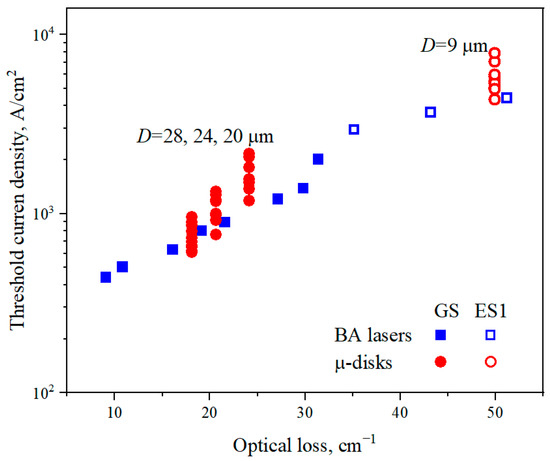
Figure 6.
Threshold current density of GS (solid symbols) and ES1 (open symbols) lasing for stripe (squares) and microdisk (circles) lasers as function of total optical loss.
4. Conclusions
The features of two-state lasing in microlasers with quantum dot active region are investigated for different disk cavity diameters at room temperature. The two-state lasing emission occurs via the ground and the first excited-state optical transitions in the microlasers larger than the critical diameter, which is estimated as 14 µm for room-temperature operation. The maximum optical loss at which GS lasing can be achieved was estimated at 33 cm−1. The coefficient describing the dependence of optical loss on the disk diameter was evaluated as 421 cm−1 × µm. The lowest threshold current densities of the microdisk lasers are in a good agreement with that of the stripe lasers, having nominally the same optical loss. Thus, the sidewall nonradiative recombination does not affect the microdisk laser characteristics. For possible application of two-state lasing in QD microdisk lasers (e.g., for a hybrid multilevel/spectral encoding), it is convenient to have a small difference between the threshold current densities for the first (GS) and the second (two-state) lasing. The experimental results obtained indicate that this difference decreases with decreasing microdisk size and completely disappears for microdisks of the critical diameter. Two-state lasing involving the first and the second excited-state optical transitions was observed for the first time in the smallest microdisk of 9 µm in diameter.
Author Contributions
Conceptualization, I.M., A.Z. and M.M.; methodology, I.M. and Y.S.; investigation, I.M. and Y.S.; data curation, E.M., N.F., A.D. and K.I.; writing—original draft preparation, I.M., A.Z. and N.K.; writing—review and editing, M.M., E.M. and K.I.; project administration, I.M., A.Z. and N.K.; funding acquisition, I.M. and N.K. All authors have read and agreed to the published version of the manuscript.
Funding
Study of microdisk lasers was supported by Russian Science Foundation grant № 22-72-00028 (https://rscf.ru/project/22-72-00028/ (accessed on 18 February 2023)) Support of optical measurements was implemented in the framework of the Basic Research Program at the National Research University Higher School of Economics (HSE University). Study of broad-area lasers was supported by the Ministry of Science and Higher Education of the Russian Federation under project FSRM-2023-0010.
Institutional Review Board Statement
Not applicable.
Informed Consent Statement
Not applicable.
Data Availability Statement
The data presented in this study are available on request from the corresponding author. The data are not publicly available due to the author’s readiness to provide it on request.
Acknowledgments
The work was carried out on the equipment of the unique scientific setup «Complex optoelectronic stand».
Conflicts of Interest
The authors declare no conflict of interests.
References
- McCall, S.L.; Levi, A.F.G.; Slusher, R.E.; Pearton, S.J.; Logan, R.A. Whispering-gallery mode microdisk lasers. Appl. Phys. Lett. 1992, 60, 289–291. [Google Scholar] [CrossRef]
- Wong, W.W.; Jagadish, C.; Tan, H.H. III–V semiconductor whispering-gallery mode microcavity lasers: Advances and prospects. IEEE J. Quantum Electron. 2022, 58, 2000618. [Google Scholar] [CrossRef]
- Zhukov, A.E.; Kryzhanovskaya, N.V.; Moiseev, E.I.; Maximov, M.V. Quantum-dot microlasers based on whispering gallery mode resonators. Light Sci. Appl. 2021, 10, 80. [Google Scholar] [CrossRef]
- Kryzhanovskaya, N.V.; Moiseev, E.I.; Kudashova, Y.V.; Zubov, F.I.; Lipovskii, A.A.; Kulagina, M.M.; Troshkov, S.I.; Zadiranov, Y.M.; Lifshits, D.A.; Maximov, M.V.; et al. Continuous-wave lasing at 100 °C in 1.3 µm quantum dot microdisk diode laser. Electron. Lett. 2015, 51, 1354–1355. [Google Scholar] [CrossRef]
- Wan, Y.; Norman, J.; Li, Q.; Kennedy, M.J.; Liang, D.; Zhang, C.; Huang, D.; Zhang, Z.; Liu, A.Y.; Torres, A.; et al. 1.3 μm submilliamp threshold quantum dot micro-lasers on Si. Optica 2017, 4, 940–944. [Google Scholar] [CrossRef]
- Kryzhanovskaya, N.; Moiseev, E.; Polyubavkina, Y.; Maximov, M.; Kulagina, M.; Troshkov, S.; Zadiranov, Y.; Guseva, Y.; Lipovskii, A.; Tang, M.; et al. Heat-sink free CW operation of injection microdisk lasers grown on Si substrate with emission wavelength beyond 1.3 μm. Opt. Lett. 2017, 42, 3319–3322. [Google Scholar] [CrossRef] [PubMed]
- Zhang, Y.-H.; Mochida, R.; Tanabe, K.; Takemasa, K.; Sugawara, M.; Iwamoto, S.; Arakawa, Y. Direct modulation of 1.3 μm quantum dot lasers on silicon at 60 °C. Opt. Express 2016, 24, 18428–18435. [Google Scholar]
- Zhukov, A.E.; Kryzhanovskaya, N.V.; Moiseev, E.I.; Dragunova, A.S.; Tang, M.; Chen, S.; Liu, H.; Kulagina, M.M.; Kadinskaya, S.A.; Zubov, F.I.; et al. InAs/GaAs quantum dot microlasers formed on silicon using monolithic and hybrid integration methods. Materials 2020, 13, 2315. [Google Scholar] [CrossRef]
- Zubov, F.I.; Moiseev, E.I.; Nadtochiy, A.M.; Fominykh, N.A.; Ivanov, K.A.; Makhov, I.S.; Dragunova, A.S.; Maximov, M.V.; Vorobyev, A.A.; Mozharov, A.M.; et al. Improvement of thermal resistance in InGaAs/GaAs/AlGaAs microdisk lasers bonded onto silicon. Semicond. Sci. Technol. 2022, 37, 075010. [Google Scholar] [CrossRef]
- Zubov, F.; Maximov, M.; Kryzhanovskaya, N.; Moiseev, E.; Muretova, M.; Mozharov, A.; Kalyuzhnyy, N.; Mintairov, S.; Kulagina, M.; Ledentsov, N.; et al. High speed data transmission using directly modulated microdisk lasers based on InGaAs/GaAs quantum well-dots. Opt. Lett. 2019, 44, 5442–5445. [Google Scholar] [CrossRef]
- Wan, Y.; Inoue, D.; Jung, D.; Norman, J.C.; Shang, C.; Gossard, A.C.; Bowers, J.E. Directly modulated quantum dot lasers on silicon with a milliampere threshold and high temperature stability. Photonics Res. 2018, 6, 776–781. [Google Scholar] [CrossRef]
- Markus, A.; Chen, J.X.; Paranthoën, C.; Fiore, A.; Platz, C.; Gauthier-Lafaye, O. Simultaneous two-state lasing in quantum-dot lasers. Appl. Phys. Lett. 2003, 82, 1818–1820. [Google Scholar] [CrossRef]
- Zhukov, A.E.; Kovsh, A.R.; Livshits, D.A.; Ustinov, V.M.; Alferov, Z.I. Output power and its limitation in ridge-waveguide 1.3 mum wavelength quantum-dot lasers. Semicond. Sci. Technol. 2003, 18, 774–781. [Google Scholar] [CrossRef]
- Kovsh, A.; Krestnikov, I.; Livshits, D.; Mikhrin, S.; Weimert, J.; Zhukov, A. Quantum dot laser with 75-nm-broad spectrum of emission. Optics Lett. 2007, 32, 793–795. [Google Scholar] [CrossRef]
- Kovsh, A.; Gubenko, A.; Krestnikov, I.; Livshits, D.; Mikhrin, S.; Weimert, J.; West, L.; Wojcik, G.; Yin, D.; Bornholdt, C.; et al. Quantum dot comb-laser as efficient light source for silicon photonics. In Silicon Photonics and Photonic Integrated Circuits; SPIE: Bellingham, WA, USA, 2008; Volume 6996, p. 69960V. [Google Scholar]
- Tykalewicz, B.; Goulding, D.; Hegarty, S.P.; Huyet, G.; Byrne, D.; Phelan, R.; Kelleher, B. All-optical switching with a dual-state, single-section quantum dot laser via optical injection. Optics Lett. 2014, 39, 4607–4610. [Google Scholar] [CrossRef]
- Maximov, M.V.; Shernyakov, Y.M.; Gordeev, N.Y.; Nadtochiy, A.M.; Zhukov, A.E. Information encoding using two-level generation in a quantum dot laser. Pis’ma v JTF (in Russian) 2023, 49, 18. [Google Scholar]
- Maximov, M.V.; Shernyakov, Y.M.; Zubov, F.I.; Zhukov, A.E.; Gordeev, N.Y.; Korenev, V.V.; Savelyev, A.V.; Livshits, D.A. The influence of p-doping on two-state lasing in InAs/InGaAs quantum dot lasers. Semicond. Sci. Techol. 2013, 28, 105016. [Google Scholar] [CrossRef]
- Markus, A.; Rossetti, M.; Calligari, V.; Chek-Al-Kar, D.; Chen, J.X.; Fiore, A. Two-state switching and dynamics in quantum dot two-section lasers. J. Appl. Phys. 2006, 100, 113104. [Google Scholar] [CrossRef]
- Lee, J.; Lee, D. Double-state lasing from semiconductor quantum dot laser diodes caused by slow carrier relaxation. J. Korean Phys. Soc. 2011, 58, 239–242. [Google Scholar] [CrossRef]
- Korenev, V.V.; Savelyev, A.V.; Zhukov, A.E.; Omelchenko, A.V.; Maximov, M.V. Effect of carrier dynamics and temperature on two-state lasing in semiconductor quantum dot lasers. Semicond. 2013, 47, 1397–1404. [Google Scholar] [CrossRef]
- Zhou, Y.; Duan, J.; Grillot, F.; Wang, C. Optical noise of dual-state lasing quantum dot lasers. IEEE J. Quantum Electron. 2020, 56, 9204736. [Google Scholar] [CrossRef]
- Wu, Y.; Jiang, L.; Asryan, L.V. Output power of a quantum dot laser: Effects of excited states. J. Appl. Phys. 2015, 118, 183107. [Google Scholar] [CrossRef]
- Zhukov, A.E.; Kryzhanovskaya, N.V.; Maximov, M.V.; Lipovskii, A.A.; Savelyev, A.V.; Bogdanov, A.A.; Shostak, I.I.; Moiseev, E.I.; Karpov, D.V.; Laukkanene, J.; et al. Lasing in microdisks of ultrasmall diameter. Semicond. 2014, 48, 1626–1630. [Google Scholar] [CrossRef]
- Talalaev, V.; Kryzhanovskaya, N.V.; Tomm, J.W.; Rutckaia, V.; Schilling, J.; Zhukov, A. Dynamics of broadband lasing cascade from a single dot-in-well InGaAs microdisk. Sci. Rep. 2019, 9, 5635. [Google Scholar] [CrossRef] [PubMed]
- Viktorov, E.A.; Mandel, P.; Tanguy, Y.; Houlihan, J.; Huyet, G. Electron-hole asymmetry and two-state lasing in quantum dot lasers. Appl. Phys. Lett. 2005, 87, 053113. [Google Scholar] [CrossRef]
- Korenev, V.V.; Savelyev, A.V.; Zhukov, A.E.; Omelchenko, A.V.; Maximov, M.V. Analytical approach to the multi-state lasing phenomenon in quantum dot lasers. Appl. Phys. Lett. 2013, 102, 112101. [Google Scholar] [CrossRef]
- Coldren, L.A.; Corzine, S.W.; Mašanović, M.L. Diode Lasers and Photonic Integrated Circuits, 2nd ed.; John Wiley & Sons: Hoboken, NJ, USA, 2012; pp. 199–218. [Google Scholar]
- Fiore, A.; Rossetti, M.; Alloing, B.; Paranthoën, C.; Chen, J.X.; Geelhaar, L.; Riechert, H. Carrier diffusion in low-dimensional semiconductors: A comparison of quantum wells, disordered quantum wells, and quantum dots. Phys. Rev. B 2004, 70, 205311. [Google Scholar] [CrossRef]
- Borselli, M.; Johnson, T.J.; Painter, O. Beyond the Rayleigh scattering limit in high-Q silicon microdisks: Theory and experiment. Opt. Express 2005, 13, 1515–1530. [Google Scholar] [CrossRef]
- Zhukov, A.E.; Moiseev, E.I.; Nadtochiy, A.M.; Fominykh, N.A.; Ivanov, K.A.; Makhov, I.S.; Maximov, M.V.; Zubov, F.I.; Dubrovskii, V.G.; Mintairov, S.A.; et al. Optical loss in microdisk lasers with dense quantum dot arrays. IEEE J. Quantum Electron. 2023, 59, 2000108. [Google Scholar] [CrossRef]
- Markus, A.; Chen, J.X.; Gauthier-Lafaye, O.; Provost, J.-G.; Paranthoën, C.; Fiore, A. Impact of interband relaxation on the performance of a quantum-dot laser. IEEE J. Selected Topics Quantum Electron. 2003, 9, 1308. [Google Scholar] [CrossRef]
- Korenev, V.V.; Savelyev, A.V.; Maximov, M.V.; Zubov, F.I.; Shernyakov, Y.M.; Kulagina, M.M.; Zhukov, A.E. Effect of modulation p-doping level on multi-state lasing in InAs/InGaAs quantum dot lasers having different external loss. Appl. Phys. Lett. 2017, 111, 132103. [Google Scholar] [CrossRef]
Disclaimer/Publisher’s Note: The statements, opinions and data contained in all publications are solely those of the individual author(s) and contributor(s) and not of MDPI and/or the editor(s). MDPI and/or the editor(s) disclaim responsibility for any injury to people or property resulting from any ideas, methods, instructions or products referred to in the content. |
© 2023 by the authors. Licensee MDPI, Basel, Switzerland. This article is an open access article distributed under the terms and conditions of the Creative Commons Attribution (CC BY) license (https://creativecommons.org/licenses/by/4.0/).